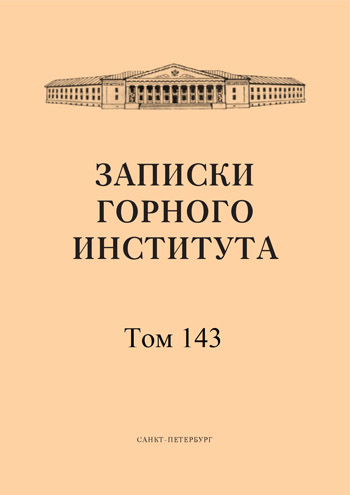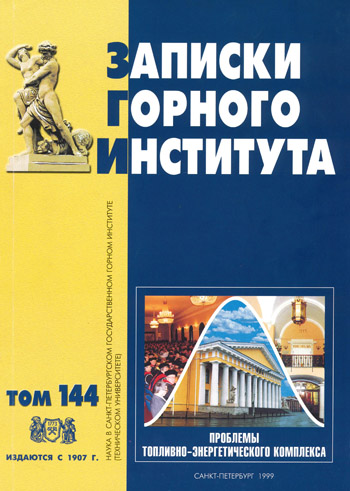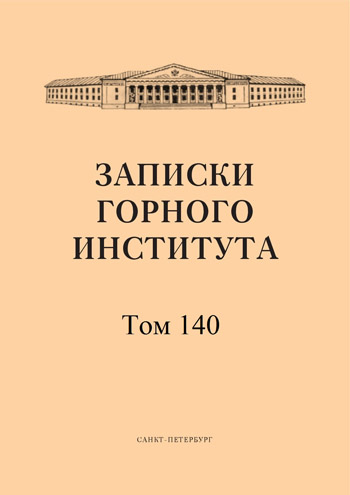-
Date submitted1996-06-02
-
Date accepted1996-07-01
-
Date published1997-09-30
To the centenary of Corresponding Member of the USSR Academy of Sciences, Professor Pavel M. Tatarinov
- Authors:
- Yu. V. Lir
- A. D. Shcheglov
The main stages of life, scientific and pedagogical activity of the outstanding geologist P.M.Tatarinov are considered.
-
Date submitted1996-06-12
-
Date accepted1996-07-29
-
Date published1997-09-30
To the problem of ore districts some theoretical and applied aspects
- Authors:
- A. D. Shcheglov
Theoretical and applied issues of geology of ore districts are considered. It is noted that the largest ore districts are often manifested in the crustal structures in isolation, without an accompanying regional background of single-age small deposits and ore occurrences. In some ore provinces there is a repeated, polychronous manifestation of ore districts without signs of regeneration of mineral matter (deposits). Large ore districts and their deposits are the most highly organized geological objects: they serve as benchmarks of certain ore formations. The signs of such ore districts are given. Ore districts are unique mineral heterogeneities of the Earth's crust, the study of which makes it possible to reveal multilateral relations in the development of different Earth shells, the nature and influence of their evolution on the peculiarities of the manifestation of ore processes. The issues of studying ore districts in the modern conditions of economic development of the country are discussed
-
Date submitted1996-06-23
-
Date accepted1996-07-20
-
Date published1997-09-30
Genetic models of crystal formation
- Authors:
- A. V. Kozlov
On the basis of the analysis of existing models of crystal formation and the results of the study of the Polar Urals crystal province, it is shown that the existing concepts are not mutually exclusive, and crystal formation is polygenic. The conditions necessary for the growth of quartz crystals can be implemented at certain stages of magmatic, metamorphic, metasomatic and tectonofluidic hydrothermal systems. The most favorable conditions for crystal formation occur at manifestation of tectonofluidic activation against the background of regressive stage of regional metamorphism of greenschist facies.
-
Date submitted1996-06-17
-
Date accepted1996-07-16
-
Date published1997-09-30
Some methodological aspects of the development of domestic metallogeny
- Authors:
- V. S. Kormilitsyn
The comparison of the results of metallogenic analysis from the positions of historical-geological and structural-material approaches is given and the fallacy and inconsistency of the latter is proved.
-
Date submitted1996-06-16
-
Date accepted1996-07-16
-
Date published1997-09-30
Time and ore bearing capacit
- Authors:
- N. V. Nikitin
- D. B. Nikitin
- P. V. Nikitin
The duration of formation of mobile zones of Caledonides, Hercynides, Kimmerides and Alpides is on average the same and is 160+/-15 Ma. The ratio of the time of formation of orogenic structures to geosynclinal structures proper in the mobile zones hosting large stratified deposits of lead and zinc is 10 %, volcanogenic copper-zinc deposits - 33 %, and rare-metal (Sn, W, Mo, Ai) - 75 %. This circumstance is connected, apparently, with the degree of warming of the Earth's crust and its processing by mantle fluid flows.
-
Date submitted1996-06-30
-
Date accepted1996-07-05
-
Date published1997-09-30
Regularities of location of primary and placer gold deposits on the example of the Omchak ore cluster
- Authors:
- N. I. Mishin
- Z. A. Stepina
The connection between the native and placer gold deposits is considered on the example of the Omchak ore cluster. Their stereological reconstruction is based on the model of the main ore-controlling fault.
-
Date submitted1996-06-12
-
Date accepted1996-07-03
-
Date published1997-09-30
On the connection between dykes and mineralization
- Authors:
- N. L. Shamanina
The considered aspects of the relationship between mineralization and dykes of different composition, age, and origin allow us to consider dykes as reliable indicators for studying the direction of tectonomagmatic and metallogenic processes of different levels, for elucidating the patterns of localization of mineralization and its prediction, for deciphering the tectonic conditions of formation of ore bodies and peculiarities of geological development of certain regions, and in some cases dykes can be carriers of both syngenetic and epigenetic mineralization.
-
Date submitted1996-06-30
-
Date accepted1996-07-03
-
Date published1997-09-30
Generalized scheme of the Valerianov volcanic-plutonic complex and its ore content
- Authors:
- G. S. Porotov
The Early Carboniferous Valerian andesitodiorite volcanic-plutonic complex is located in the Turgai Trough. It is composed of gabbro-granodiorite intrusive rocks, basalt-rhyolite volcanic rocks and dikes of different composition. The complex consists of several magmatic nodes represented by paleovolcanic structures. Comparison of the structure of paleovolcanic structures located at different levels of erosional section allows us to create a generalized model of the complex. The complex is genetically associated with skarn-magnetite and associated minerals.
-
Date submitted1996-06-22
-
Date accepted1996-07-04
-
Date published1997-09-30
Structure formation conditions of the Bazhenov chrysotile-asbestos deposit and regularities in the distribution of natural and industrial ore types
- Authors:
- V. I. Efimov
- V. P. Barabanov
The primary role of the fault zone in the formation and preservation of chrysotile-asbestos mineralization of the Bazhenov subtype, which can be attributed to deposits of near-fault metamorphism, has been established.
-
Date submitted1996-06-18
-
Date accepted1996-07-12
-
Date published1997-09-30
Iron ore deposits of the Kola Peninsula as self-organizing systems
- Authors:
- P. M. Goryainov
- D. G. Egorov
- G. Yu. Ivanyuk
The Archean iron ore formations are considered, which possess large-scale self-similarity, a combination of chaotic and orderliness at different scale levels, coherence of features of formally different nature, fractality, i.e. features characteristic of deterministic-chaotic systems. The application of special methods of the theory of dynamical systems allowed us to obtain a quantitative measure of the complexity of the dynamics of ore genesis.
-
Date submitted1996-06-24
-
Date accepted1996-07-15
-
Date published1997-09-30
Evolution of properties of placer-forming minerals in the process of migration
- Authors:
- I. A. Karyakin
During the complex pathway from bedrock sources to placers, hypergenetically stable minerals (gold, platinum, cassiterite ilmenite, pyrope, diamond, etc.) evolve with noticeable changes in many properties. The main factors are strength selection among individuals of the same mineral species, mechanical activation of the surface of grains during their grinding, removal of impurity elements, partial dissolution and re-deposition of mineral matter.
-
Date submitted1996-06-08
-
Date accepted1996-07-07
-
Date published1997-09-30
Deterministic fractal models. Application experience
- Authors:
- Yu. V. Lir
- S. S. Shakin
On the material of the thoroughly studied Deputatskoye tin ore deposit (Yakutia) the research aimed at revealing the possibility of describing the structure of the deposit by a deterministic fractal model has been carried out. The essence of the study is the search for a function mapping a large structure to its part. The properties of such a mapping were checked by dividing the investigated area into M x N equal-sized elements (cells), and M and N were taken equal to 8,16,32,64,128. In each cell, the average tin reserves in metric percent were calculated and the similarity between the reference (8 x 8 cell) and the object as a whole was assessed, taking into account the possible rotation of small-sized structures relative to large ones. It was found that the maximum number of cells similar to the etalon is revealed when using the 64 x 64 network, and the 64 x 128 network identifies as "etalon-like" the most morphologically complex nodes that are most enriched in tin.
-
Date submitted1996-06-25
-
Date accepted1996-07-23
-
Date published1997-09-30
On the structure of the platinum-bearing Fedorovo-Pan intrusion (to the method of predicting mineralization)
- Authors:
- Yu. L. Voitekhovskii
Attention is paid to the coordinated character of matter differentiation in the Fedorovo-Pan intrusive at several hierarchical levels: geochemical, mineral, petrographic and geological-structural. A new approach based on the algebraic theory of quadratic forms was used to systematize petrographic structures. It is suggested that the above structuring of matter is caused by the formation of intrusive rocks in the conditions of thermodynamically open system.
-
Date submitted1996-06-09
-
Date accepted1996-07-03
-
Date published1997-09-30
Features of metamorphism of cuprous and chromitic sediments in the Olekmo-Vitim province
- Authors:
- Yu. V. Bogdanov
The features of regional and contact metamorphism of cuprous sediments and catagenetic transformations of chromium sediments are considered. The conditions of formation of chromium-bearing glauconite are characterized. It is shown that ore formations (veins, skarns, hornblende, etc.) formed during regional and contact metamorphism can be used as search signs.
-
Date submitted1996-06-02
-
Date accepted1996-07-06
-
Date published1997-09-30
Prospects and problems of exploitation of gold-bearing placers in the Arctic shelf regions of Russia
- Authors:
- V. G. Kuzmin
- M. V. Nikitin
The results of the study of placer gold content in the Arctic shelf regions of Russia allow us to identify the main geological and industrial types of placers and determine their resource intensity. For placers of coastal-marine genesis the problem of fine gold extraction for sampling and exploitation is acute, which is successfully solved by using modern domestic enrichment apparatuses. High economic efficiency of exploitation of buried placers on coastal-marine plains, shallow shelf and on islands from under glaciers can be achieved by application of borehole hydro-technology of extraction developed in Russia.
-
Date submitted1996-06-11
-
Date accepted1996-07-21
-
Date published1997-09-30
New finds of non-metallic minerals in the eastern provinces of Cuba
- Authors:
- L. V. Kulachkov
- K. A. Leyva Rodriguez
New occurrences of non-metallic minerals are described: vein quartz, rock crystal, talc-bearing rocks, Iceland spar, jasper rock, marble onyx, ceramic, abrasive and collectible raw materials. Cuba's non-traditional minerals predominate, some of which are imported.
-
Date submitted1996-06-20
-
Date accepted1996-07-27
-
Date published1997-09-30
The fact base and theoretical foundations of coal geology
- Authors:
- V. V. Kiryukov
On the basis of logical analysis the peculiarities of factual and theoretical base of coal geology are considered, the necessity of its revision and updating in connection with the transfer of all information of geological exploration works in ACS-inform and system approach is shown.
-
Date submitted1996-06-08
-
Date accepted1996-07-10
-
Date published1997-09-30
Use of mathematical models of geological objects in the course "Prospecting and Exploration of Mineral Deposits"
- Authors:
- O. V. Lepin
The article shows the importance of mathematical models for developing students' practical skills in prospecting, sampling and exploration of minerals.The main types of mathematical models of geological objects used for solving educational problems are considered, using the example of two geological objects - bauxite-bearing and mica-bearing territories. Automated training systems created on the basis of these models and their role in the educational process are characterized.
-
Date submitted1996-06-06
-
Date accepted1996-07-29
-
Date published1997-09-30
"Description of the Use of the Experimental Fifka", an eighteenth-century manuscript
- Authors:
- V. G. Bauman
- D. K. Salakhutdinova
The manuscript of the translation of the article by the Swedish mineralogist Thorburn Bergman, made at the Nerchinsk mines in 1780 by A.M.Karamyshev and E.E.Barbot de Marney, kept in the Main Library of SPGGI, is examined in detail for the first time. The manuscript is the first work in Russian devoted to the soldering tube, in the terms of the 18th century - an "experimental fifka". A full bibliographic description of the manuscript is given and the circle of persons whose fates are connected with this manuscript is indicated.


